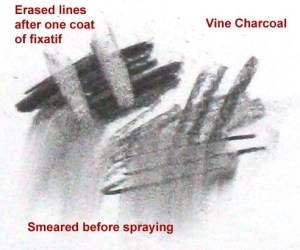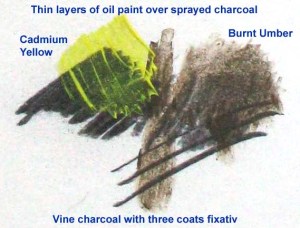
Fixative Spray on Charcoal Drawings
May 4, 2014
I wanted to take a moment during the process of this charcoal drawing I’m working on to share my experience with using fixative sprays. The purpose of a fixative (a.k.a. fixatif) is to adhere the loose dry mediums like charcoal, pastel, or graphite to the surface and prevent them from smearing. This is accomplished by acrylic resin in the spray.
Most fixatives come in spray cans. There are “workable” or “final” options. Final is essentially a varnish. “Workable” is what I prefer to always use. This type allows me to continue to add more drawing to the surface if I choose; whereas, a final should only be used when the drawing is finished. I get best results by holding the can no closer than a foot from the surface, preferably outside in a slight breeze that will diffuse the spray more. 1 coat is adequate for the lighter shaded areas, but the darker areas will need more. You can still lighten (but not completely erase) areas that have only 1 coat, and dark areas would still smear, but 2 or 3 coats cannot be erased or smeared. Let the spray dry about 10 minutes between coats, and an hour before drawing over the workable sprayed area.
I want to be certain that any loose charcoal powder is off the drawing before I spray it. First, I’ll tap the back of the drawing facedown over some newspaper to get off as much as I can. If you hold the can too close to the drawing, the air will blow around any loose powder, which can be a problem in carefully rendered areas. Spray the fixative in a direction where any blown powder will cause the least noticeable problem, ideally off the edge of the paper, or across dark areas. You can also mask areas with sheets or pieces of torn paper.
Krylon Workable Fixative is the brand I currently use. I’ve seen online that this is described as being available in Matte or Gloss, which is incorrect. Their Matte Finish (#1311) is not workable. Get the one with “Workable Fixatif” #1306 on the label, which is described as “gloss” but I don’t notice that except on graphite or charcoal pencils, and even then it’s more “satin” than “gloss.” The fumes are very strong, so you must use this in a well-ventilated area, and keep the work there for 10-15 minutes until it completely dries. If you work on thin paper, the drying resin in the fixative can cause the paper to curl, so tape it down or press it flat as it dries. Grumbacher is another brand of workable fixative, and comes in a matte finish.
FYI, Daler Rowney has a fixative called Perfix that also comes in liquid form in a jar. The benefit of that is that you can go old-school and use a mouth atomizer to apply your spray. That takes some practice to get used to, but you should try it if you want to avoid the fumes from a spray can. Perfix is a final, not a workable fixative, however.
One last thing, if you use charcoal to sketch on a canvas before painting in oil, you can use a fixative to prevent the oils from mingling with the charcoal. Be sure and only use a “workable” fixative in that case, and notice that the oil layer may dry a little more slowly than usual.
Links:
Krylon Workable Fixatif
Grumbacher Workable Fixative
Daler-Rowney Perfix
Mouth Atomizer at Dick Blick store




Leave a comment